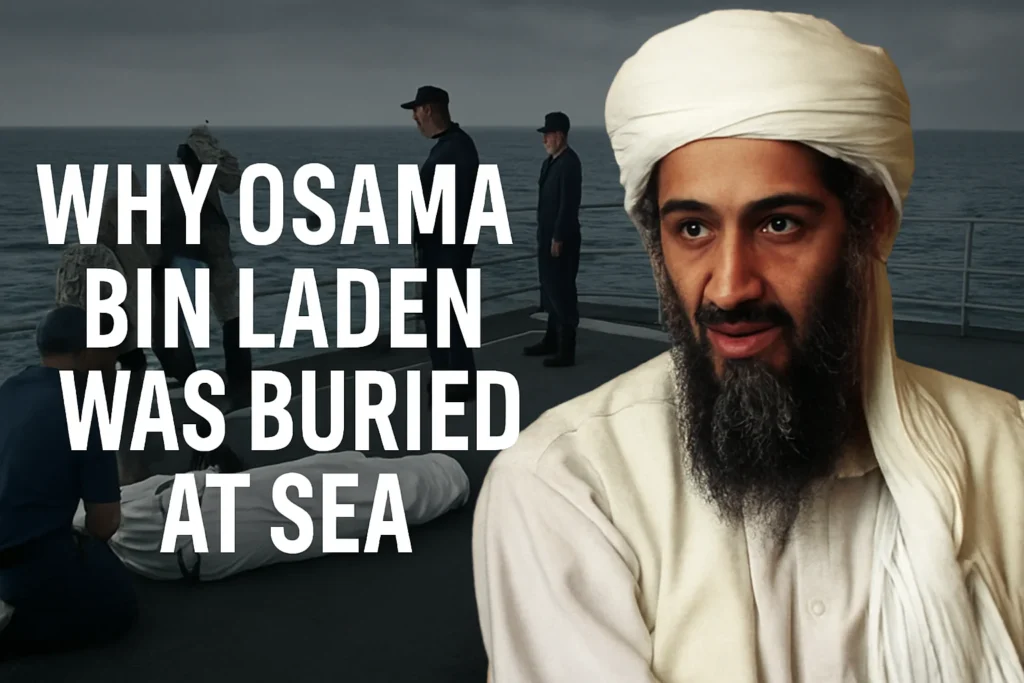The predawn stillness of the North Arabian Sea on May 2, 2011, was shattered only by the rhythmic thrum of the USS Carl Vinson’s engines. Beneath a shroud of weighted canvas on the aircraft carrier’s vast deck lay a body that had consumed the attention of global superpowers for a decade. A small, solemn group of U.S. personnel stood at attention as a naval officer recited Arabic prayers into the salt-tinged air. With a practiced motion, the platform tilted, and the shrouded form slid into the ink-black, churning depths – vanishing forever into the abyss. Osama bin Laden, the architect of modern terror, was consigned not to earth, but to the eternal anonymity of the deep ocean. This is the definitive account of the man who reshaped global conflict, and the meticulously calculated reasons America chose a watery grave as his final resting place.
The Gilded Cage: Birthright and Early Radicalization (1957-1979)
Born in Riyadh in 1957, Osama bin Mohammed bin Awad bin Laden entered the world as the 17th son of Mohammed bin Laden, a Yemeni immigrant turned construction titan whose company rebuilt Islam’s holiest sites and forged deep ties with the Saudi royal family. Osama’s childhood in Jeddah was one of staggering privilege – palaces, servants, elite education. Yet beneath the gilded surface simmered a profound religious intensity.
- A Mother’s Influence & Early Piety: His Syrian mother, Alia Ghanem, instilled deep devotion, though his father’s death in a 1967 plane crash left young Osama adrift within the vast bin Laden clan. He gravitated towards fundamentalist interpretations of Islam, influenced by scholars like Abdullah Azzam, who preached a return to “pure” Islam and resistance against Western corruption.
- University Years: The Seeds of Discontent: At King Abdulaziz University in Jeddah (studying economics/public administration), Osama immersed himself in religious texts and the writings of Sayyid Qutb, the Egyptian Muslim Brotherhood ideologue executed in 1966. Qutb’s visceral hatred of Western “jahiliyya” (ignorance and godlessness), his experiences witnessing American social freedoms during studies in Colorado, and his conviction that true Muslims must fight corrupt Muslim rulers colluding with the West, deeply resonated with the young, idealistic bin Laden. He began framing the world through an apocalyptic lens of religious struggle.
Afghan Crucible: Forging the Jihadist (1979-1989)
The Soviet invasion of Afghanistan in December 1979 ignited bin Laden’s destiny. He saw it as a divine call – a chance to defend fellow Muslims against atheist invaders.
- The Billionaire Mujahid: Leveraging his family’s wealth, construction expertise, and Saudi royal connections, bin Laden became a key player:
- Logistics Master: He financed and organized the “Maktab al-Khidamat” (MAK – Services Office) with Abdullah Azzam, channeling money, weapons, and volunteers from across the Muslim world to the Afghan Mujahideen.
- Myth Maker: He personally fought (though his combat role was often exaggerated), building roads and tunnels near the front lines. His wealth allowed him to fund hospitals and guesthouses, cultivating an image of the pious warrior-prince. (Image: Bin Laden in Afghan garb, Kalashnikov nearby, mid-1980s)
- CIA’s Unwitting Ally: Crucially, the US CIA, funneling billions through Pakistan’s ISI, actively supported the Mujahideen, including factions linked to bin Laden. Money, weapons (like Stinger missiles), and training flowed, creating an unholy alliance against the Soviets. Bin Laden learned invaluable lessons in guerrilla warfare, international fundraising networks, and the power of US support – lessons he would later turn against his benefactors.
- The Birth of Al-Qaeda (“The Base”): As the Soviets retreated in 1989, bin Laden and Azzam disagreed. Azzam favored continuing humanitarian work. Bin Laden, radicalized by the victory, saw a new calling: global jihad against corrupt Muslim regimes and their Western backers. He formed al-Qaeda as a vanguard for this holy war. When Azzam was assassinated in 1989 (likely by bin Laden’s allies), the path was clear.
Exile, Betrayal, and the Path to 9/11 (1989-2001)
Bin Laden returned to Saudi Arabia a hero, but his worldview soon clashed violently with reality.
- The Gulf War Catalyst: The 1990 Iraqi invasion of Kuwait and the subsequent stationing of 500,000 US troops on Saudi soil – land containing Islam’s two holiest cities, Mecca and Medina – was the ultimate betrayal in bin Laden’s eyes. He denounced the monarchy for inviting “infidels” to defend the kingdom, arguing true Muslims should fight. The regime revoked his passport, froze assets, and exiled him in 1992.
- Sudan Sanctuary & Global Network Building: In Sudan, bin Laden rebuilt al-Qaeda into a structured, multinational terror organization:
- Business Fronts: Used construction and agricultural businesses to fund operations.
- Global Recruitment: Attracted veterans of the Afghan war and new radicals from Egypt, Algeria, Yemen, and beyond.
- Early Strikes: Orchestrated the 1993 World Trade Center bombing (a precursor to 9/11) and trained Somali militants involved in the 1993 Black Hawk Down incident.
- Formal Declaration of War: His February 1998 “fatwa” (published in London’s Al-Quds Al-Arabi newspaper), co-signed with Ayman al-Zawahiri of Egyptian Islamic Jihad, declared: “The ruling to kill the Americans and their allies—civilians and military—is an individual duty for every Muslim who can do it in any country in which it is possible to do it.” This provided the ideological justification for mass-casualty attacks on civilians.
- Afghanistan Under the Taliban: Launching the War on America: Expelled from Sudan under intense US pressure in 1996, bin Laden found sanctuary with the nascent Taliban regime in Afghanistan. Mullah Omar, the Taliban leader, offered protection in exchange for money and fighters. From Afghan training camps, bin Laden directed:
- August 7, 1998: US Embassy Bombings (Nairobi & Dar es Salaam): Simultaneous truck bombs killed 224 (12 Americans) and injured thousands.
- October 12, 2000: USS Cole Bombing (Aden, Yemen): Suicide bombers killed 17 US sailors.
- The Ultimate Spectacle: Years of meticulous planning culminated in September 11, 2001. Nineteen al-Qaeda hijackers crashed four planes into the World Trade Center, the Pentagon, and a field in Pennsylvania, killing 2,977 people from 90+ nations. Bin Laden achieved his goal: catastrophic terror on American soil, shattering the myth of US invincibility.
The Decade in Shadows: The Manhunt (2001-2011)
The US launched the Global War on Terror. Afghanistan was invaded, the Taliban routed, but bin Laden vanished into the mountains along the Pakistan-Afghanistan border. He became a phantom:
- Tora Bora Failure (Dec 2001): US forces nearly captured him in the Tora Bora cave complex but he escaped, likely into Pakistan’s Federally Administered Tribal Areas (FATA).
- Life on the Run: He relied on a small cadre of trusted couriers, strict operational security (no electronic communications), and the protection of sympathetic elements within Pakistan’s intelligence service, the ISI. His world shrank to isolated safehouses.
- Ghostly Presence: Issuing occasional, grainy audio or video tapes – taunting the West, justifying attacks, rallying followers – he remained a potent symbolic figurehead for global jihad. Rumors placed him everywhere: Yemen, Somalia, Iran. The trail seemed permanently cold.
Abbottabad: The Unlikely Sanctuary
The breakthrough came not from high-tech surveillance, but from old-fashioned intelligence work tracking people:
- The Courier: Years of interrogating detainees (including Khalid Sheikh Mohammed, the 9/11 operational planner) repeatedly mentioned a vital bin Laden courier known by aliases “Abu Ahmed al-Kuwaiti” and “Sheikh Abu Ahmed.” Finding him was key.
- Tracking the Ghost: By 2010, CIA analysts identified the courier’s real name and located his brother in Pakistan. Surveillance led them to a peculiar, high-walled compound in Abbottabad, Pakistan – a leafy, military garrison town just 35 miles from Islamabad, home to Pakistan’s elite military academy.
- The Pacer: Satellite imagery and ground surveillance revealed astonishing details:
- Fortress-Like: 12-18 foot walls topped with barbed wire, internal walls for privacy, balconies shielded by high walls.
- No Digital Footprint: No phone lines, no internet connection. Residents burned trash instead of putting it out.
- The Mystery Man: A tall figure, dubbed “The Pacer,” was seen walking for hours daily in a small, internal courtyard – never leaving the compound. His height (estimated 6’4″ – 6’6″) matched bin Laden’s.
- Costly Anomaly: The $1 million property was vastly beyond the means of the courier’s declared income. By early 2011, CIA Director Leon Panetta assessed with “high confidence” that Osama bin Laden lived there.
Operation Neptune Spear: Minutes That Changed History (May 1-2, 2011)
President Barack Obama faced an agonizing decision: risk a raid or bomb the compound, potentially without proof of kill. He chose the raid.
- The Team: US Navy SEAL Team Six (DEVGRU), the nation’s premier counter-terrorism unit.
- The Insertion: Two modified stealth MH-60 Black Hawk helicopters lifted off from Jalalabad, Afghanistan, on May 1st. Their mission: infiltrate Abbottabad, secure bin Laden, gather intelligence, and exfiltrate – all within minutes.
- The Crash & Assault: One helicopter suffered a “vortex ring state” due to the compound’s high walls and hot air, crashing hard inside the perimeter. The SEALs stormed the main building, breaching doors and clearing rooms methodically under intense pressure.
- The Kill: On the third floor, SEALs encountered bin Laden. In a tense, close-quarters moment within a small room, shots were fired. Bin Laden was hit twice – once in the chest and once fatally above the left eye. A woman (later identified as Amal Ahmed Abdul Fatah, his youngest wife) was wounded in the leg. The firefight lasted seconds.
- Intelligence Goldmine: SEALs secured bin Laden’s body, a treasure trove of intelligence: laptops, hard drives, thumb drives, documents, and handwritten notes. Facial recognition software on-site provided an initial match. To prevent the crashed helicopter’s sensitive tech from falling into enemy hands, it was destroyed with explosives. Within 38 minutes, the SEALs were airborne with their prize.
- Positive ID: The body was flown to Bagram Airbase, Afghanistan. DNA testing comparing samples to a sister who had died in Boston provided irrefutable confirmation: It was Osama bin Laden.
The Weighty Decision: Why Burial at Sea?
Facing the body of the world’s most notorious terrorist, the Obama administration swiftly ruled out traditional burial. The decision for sea burial was driven by three interlocking imperatives:
- Denying the Martyr’s Shrine: The Paramount Concern
- The Symbolic Power of Graves: Bin Laden was revered as a heroic “Sheikh” by radical Islamists globally. A known land grave, even unmarked, held immense risk of becoming a pilgrimage site (ziyarat) – a place for followers to gather, venerate, pledge allegiance, and draw inspiration for future attacks. The graves of lesser jihadist figures had already proven problematic.
- Absolute Anonymity: The deep ocean offered the only guarantee of permanent inaccessibility. There would be no coordinates, no marker, no physical location for devotion or defiance. As then-CIA Director Leon Panetta stated bluntly: “The goal was to make sure that it would not become a shrine… We didn’t want to create a situation where his burial would become an issue.” The sea ensured symbolic erasure.
- Preventing Desecration Fears: Conversely, burying him on land also risked his grave being desecrated by enemies, creating its own potent martyrdom narrative or sparking retaliatory violence. The sea neutralized both risks.
- Navigating Islamic Obligations: Respectful Expediency
The US sought to handle the body in a way that, while unorthodox, demonstrated respect for Islamic rites to deny propaganda value and mitigate Muslim backlash:- Observing the 24-Hour Rule: Islamic tradition mandates burial as soon as possible, ideally within 24 hours. Bin Laden was killed around 1:00 AM Pakistan time on May 2nd. The burial at sea was completed by approximately 1:00 AM EST on May 2nd (10:00 AM Pakistan time), meeting this critical window.
- Performing Ritual Washing (Ghusl): On board the USS Carl Vinson, bin Laden’s body was washed by a Muslim member of the military team according to Islamic rites. Water was used, and the procedure followed traditional protocols as closely as possible for an enemy.
- Shrouding (Kafan): The body was wrapped in a white shroud, consistent with Islamic practice. The shroud was weighted to ensure rapid sinking.
- Funeral Prayer (Salat al-Janazah): A Muslim naval officer recited the Janazah prayers in Arabic. The prayers were adapted, reportedly omitting the traditional supplication for God’s mercy upon the deceased and instead focusing on general Islamic funeral rites appropriate for a Muslim, albeit one considered an enemy combatant by the officiating state.
- Location in International Waters: Burial occurred in the North Arabian Sea, specifically chosen as deep international waters, avoiding the territorial waters of any nation and respecting the Islamic preference for burial within land, but acknowledging the impossibility. Some Islamic scholars later argued sea burial is permissible only if death occurs at sea or land burial is impossible (e.g., plague), while others condemned it outright for bin Laden. The US aimed for a defensible, expedient solution that acknowledged religious sensitivities without granting undue legitimacy.
- The Geopolitical Minefield: No Nation Would Take Him
Finding a country willing to accept bin Laden’s body was politically toxic and logistically impossible:- Saudi Arabia: His birthplace had stripped him of citizenship in 1994 for sedition. Accepting his body risked legitimizing him among domestic dissidents, inflaming internal tensions, or creating a focal point for extremists within the kingdom. The royal family wanted nothing to do with him.
- Pakistan: The raid was a massive violation of Pakistani sovereignty, causing deep humiliation and anger within the military and ISI. Accepting the body would have been politically explosive domestically, potentially sparking violent protests or ensuring the grave became a shrine for Pakistani extremists. The government categorically refused.
- Yemen (Ancestral Homeland): While bin Laden’s father was Yemeni, the country was (and remains) deeply unstable, plagued by al-Qaeda in the Arabian Peninsula (AQAP). Accepting his body would have been a security nightmare and a propaganda coup for local militants.
- Sudan (Former Host): Had expelled him under US pressure and had no desire to invite back the world’s most infamous terrorist corpse.
- The Sea as Neutralizer: Burial in international waters was the only solution that imposed no burden on any nation, avoided diplomatic crises, and sidestepped the intractable problem of finding willing hosts. It was geopolitically clean.
The Aftermath: Intelligence, Controversy, and Enduring Shadows
- The Intelligence Bonanza (The Abbottabad Trove): The material seized – over 6,000 documents, hundreds of digital files, and personal journals – was a counterterrorism goldmine. Dubbed “The Abbottabad Papers,” it revealed:
- Bin Laden’s active, hands-on leadership of al-Qaeda, despite years of speculation he was merely a figurehead.
- Detailed communications with affiliates worldwide (AQAP, AQI, al-Shabaab).
- Strategic planning, including plots against US rail lines and discussions of assassinating President Obama.
- His isolation, frustrations with incompetent underlings, and obsession with media coverage of al-Qaeda.
- This intelligence led to numerous raids and significantly disrupted al-Qaeda’s operations globally.
- Conspiracy Theories and Controversy:
- Proof of Death: The US refusal to release death photos fueled theories bin Laden wasn’t killed or died earlier. The administration argued releasing them would be gratuitously violent and inflammatory. DNA evidence and contemporaneous SEAL accounts are considered conclusive by experts.
- Burial Legitimacy: Muslim scholars worldwide debated the Islamic permissibility of the sea burial. Critics argued it violated tradition without sufficient justification; supporters noted the unique security imperative. The debate persists.
- Pakistan’s Fury: The raid caused a massive rupture in US-Pakistan relations. Pakistan condemned the violation of its airspace and sovereignty. Suspicion grew that elements within the ISI had sheltered bin Laden, leading to deep mistrust that lingers today. The US suspended significant military aid.
- Enduring Legacy & Evolution of Terror:
- Symbolic Victory, Persistent Threat: Bin Laden’s death was a massive symbolic and operational blow to core al-Qaeda. However, it accelerated the fragmentation of the global jihadist movement.
- Rise of the Franchises & ISIS: Affiliates like AQAP and al-Qaeda in the Islamic Maghreb (AQIM) grew stronger regionally. More significantly, the power vacuum and the Syrian civil war fueled the rise of the even more brutal Islamic State (ISIS/ISIL), which openly challenged al-Qaeda’s leadership and methodology before its own territorial collapse.
- Ideological Persistence: Bin Laden’s core ideology – violent jihad against the West and “apostate” Muslim regimes, justified by a fundamentalist interpretation of Islam – remains potent. It continues to inspire attacks worldwide, adapting to new technologies and geopolitical landscapes.
Conclusion: Oblivion as Strategy
Osama bin Laden’s journey – from the marble halls of Saudi palaces, through the crucible of the Afghan jihad, to the paranoid isolation of a Pakistani compound – ended not with martyrdom celebrated on land, but with anonymity in the crushing, lightless depths of the North Arabian Sea. The US decision for sea burial was a coldly pragmatic act of strategic erasure. It wasn’t about honoring ritual, but about neutralizing a symbol. By denying his followers a grave to pilgrimage to, and his enemies a site to desecrate, the US sought to extinguish the physical focal point of his dark mythology. The carefully orchestrated rituals performed on the USS Carl Vinson were less about piety and more about denying propaganda ammunition. In the vast, indifferent expanse of the ocean, the man who sought to reshape the world through terror was reduced to nothing – his body consumed by the currents, his grave marked only by coordinates known to a few, soon forgotten. The sea, immense and eternal, became the only entity capable of holding the weight of his infamy without consequence. The waves closed over the weighted shroud, leaving behind the complex legacy of global terror, the scars of 9/11, and the enduring, unsettling truth that while the architect was gone, the blueprint for his hatred remained. His burial at sea was the final, calculated act in a decades-long struggle: an attempt to bury not just a body, but an idea, in the deepest oblivion imaginable.



